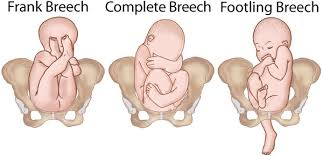Just a few weeks before delivery, most babies move into a position where there head is close to the birth canal. This is the normal delivery position for your baby. It is not always the case though. It is possible that your baby is in a reverse position with the buttocks or feet towards the birth canal. This is "breech presentation" and occurs in 1 out of 25 full-term births. Your health care provider usually takes necessary steps to bring your baby back into a normal delivery position to prevent breech baby birth defects.
What Is the Rate of Having Birth Defects with Breech Baby?

Statistics show that breech babies are more likely to develop congenital and birth-related problems after delivery. Still, you should not automatically assume that your breech baby would have birth defects because ninety-three percent of breech babies do not have any birth defects. It means the risk is small but it is very much possible to see your breech baby has a development abnormality.
While most experts believe that a head-down position or vertex position is actually the first development milestone, it does not mean that breech baby birth defects will always occur. The risks of a normal positioned baby being born with developmental issues are 2.4%, whereas the risks of a baby with breech position having a developmental defect are 6.3%. The difference is small, but it certainly increases the risk to some extent.
Possible Birth Defects That May Happen
Your baby with birth defects usually means that he/she has congenital or physical abnormalities at the time of birth. Birth defects are usually the underlying cause of high mortality death in babies. This is more likely the case when your baby is in a breech position as the umbilical cord can get pressed when the water breaks and your baby is in a breech position. This pressure restricts the supply of oxygen to the baby, which in turn leads to the development of certain birth defects.
In terms of breech baby birth defects mentioned below may occur:
- Autism: Your breech baby may develop a brain disorder called autism that affects communicative and social patterns. When your baby is in a breech position, there are always chances of cord compression and cord prolapse. Both of these issues can interfere with the supply of oxygen to the baby, which in turn causes brain damage leading to issues, like autism and more.
- Down Syndrome: A normal baby receives 46 chromosomes from parents, but your baby develops Down syndrome when they receive 47 chromosomes. The presence of that extra genetic material causes developmental issues in babies. While breech birth may have a role to play, there is insufficient evidence to say anything for sure. It is usually not possible to do anything to prevent Down syndrome.
- Chromosomes: Issues with the structure or levels of chromosomes may also be linked to breech birth. When this happens, the result is mental retardation. In many cases, breech babies may also develop cardiovascular diseases.
- Other Birth Defects: Some other breech baby birth defects are associated with spinal cord. When your baby is in a breech position, there is always a higher risk of giving birth to a baby with shunted muscular growth and spinal deformities.
Complications with Breech Baby
Even when there are no evident birth defects, there may still be certain complications you may have to experience when your baby is in a breech position. For instance:
- Umbilical Cord Prolapse: This calls for immediate medical assistance because it happens when the umbilical cord enters the birth canal before the baby. This may cause an obstruction in the flow of blood to the baby and may even lead to life-threatening consequences for the baby. The issue is rather common in the footling breech.
- Placenta Previa: In case of a breech delivery, the placenta is sometimes overlying to the birth canal. When this happens, you may have to deal with bleeding, which could be quite severe in some cases. The baby cannot change a breech position because of the placenta being in the way.
- Uterine Abnormalities: Intrauterine adhesions, uterine septum, or fibroids are some of the most common uterine issues associated with your baby being in the breech position. Exactly when these problems occur is hard to tell because most women do not experience any symptoms.
- Difficult Delivery: You are going to experience severe labor pain because of your baby being in a breech position. Some babies even sustain injuries, such as the fracture of the arm and shoulder.
